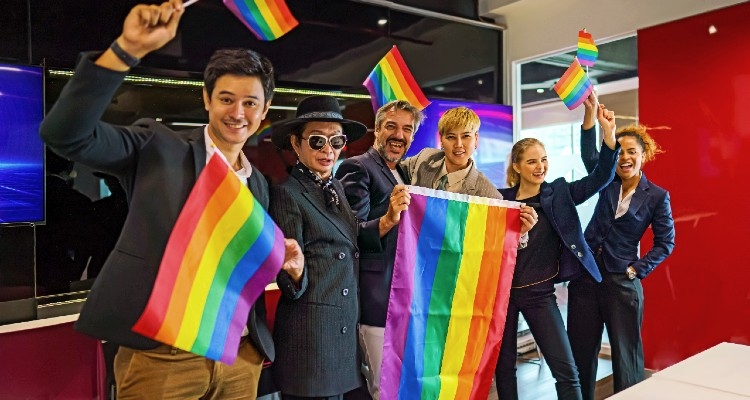Wed 09 Feb 2022

The areas where organisations can act on to foster LGBT+ diversity and inclusion in the workplace
By Murielle Gonzalez
Sexual orientation, or gender identity, is one of people's protected characteristics and thus a component of diversity in the workplace — and the LGBT+ community (the umbrella term for individuals who identify as lesbian, gay, bisexual, or trans) is growing. For example, the number of people in the UK who identify as lesbian, gay, or bisexual (LGB) has reached 1.4 million, according to the 2019 sexual orientation report by the Office for National Statistics (ONS). The data, released in May last year, revealed a statistically significant increase from 1.2 million people in 2018. Penelope McClure from the Population Statistics Division at the ONS said the proportion of adults identifying as LGB is increasing, but at a slower pace compared to people aged 16 to 24. But statistics aside, is your organisation a reflection of the LGBT+ diversity in society?
LGBT+ inclusion at work is riddled with cultural barriers, misconceptions and bias. For starters, LGBT+ diversity is less visible than other aspects of diversity because it is only with the full disclosure of individuals that we know about their LGBT+ identity.
Among the challenges of LGBT+ diversity and inclusion in the workplace are shortcomings in the knowledge about this community and its history, despite raising awareness in February for LGBT+ history month. Arguably, the LGBT+ community is primarily seen as the 'rainbow people' coming out at Gay Pride events across the globe.
"Most people I meet for the first time assume that I'm straight because they've got stereotypes in their mind about the LGBT+ community. I see their attitude change when they find out that I'm not," said Dave Sweeney, a sales and marketing professional at a global recruitment company based in Glasgow. Sweeney (pictured) is a bisexual man in a same-sex relationship and host of Visibility in Action, a podcast in which he talks to LGBT+ professionals in the STEM sector about their experience at work.
Sweeney has been true to his bisexual identity in his private and professional life for the past ten years. He told Dods Diversity & Inclusion that Visibility in Action is a personal project, which he conducts with the support of his employer. "One of the reasons I left my previous job was that I didn't feel safe about being my true self at work," he explained.
The 2021 CIPD report' Inclusion at Work, perspective on LGBT+ working lives' confirms Sweeney's statement. The report found that organisations need to do more to eradicate discrimination and harassment and work harder to create psychologically safe and inclusive workplaces.
One of the key findings of the CIPD report is that LGBT+ employees are more likely to experience workplace conflict than their heterosexual, cisgender counterparts, with 40% LGBT+ workers and 55% of trans workers having experienced harassment compared with 29% of heterosexual, cisgender employees.
In addition, a higher proportion of LGBT+ workers (16%) feel psychologically unsafe in the workplace compared with heterosexual workers (10%). For trans workers, this figure is 18%.
Progress on LGBT+ diversity at work is slow, but awareness of the importance of LGBT+ inclusion in the workplace is increasing, partly due to the recognition of the benefits LGBT+ diversity brings to organisations. For example, people perform better when they can be themselves, which comes a long way for an organisation's culture, outcomes, and performance.
Unfortunately, members of the LGBT+ community still conceal their sexual orientation due to fear of discrimination — 35% of LGBT+ staff, according to the 2018 Stonewall report. Moreover, nearly two-thirds of young people who had come out at university go back into the closet when they get their first job due to fear of discrimination.
The road to LGBT+ inclusion at work
There are three areas where organisations can act on to foster LGBT+ inclusion at work — workplace conflict, psychological safety and wellbeing, and inclusive policies and practices. Staff networks and engaging allies and role models in the organisation also promote LGBT+ inclusion in the workplace.
Policies and guidance tend to be the building blocks of the inclusive culture of an organisation, and these frameworks are particularly relevant to recruitment and promotion. However, understanding that diversity is complex and not limited to gender or race is essential. Equally important is to avoid falling into the trap of so-called positive discrimination with recruitment or promotion of LGBT+ staff as a tick-box exercise.
"Companies talk about diversity, but all they mean is race or gender because they want to make sure they are visibly diverse," said Sweeney. "Typically, 80% or more of the pool of candidates we look at will be white men, just because of the nature of the sectors we work with," he added.
For Sweeney, one way to avoid positive discrimination in recruitment is making sure the process gives everyone a fair opportunity. "If recruiters are only looking for candidates and spaces where a certain type of person can be found, they're only going to find that type. So, I think it is important to make sure you're looking as broad a range of sources as possible," he said.
To the point
Dave, what can organisations do to foster LGBT+ diversity in the workplace?
This is something a few of my podcast guests have spoken about, and I think the key is making sure people at work understand gender identity and aren't afraid to ask questions. Most LGBT+ people won't mind answering questions if they see that there is a genuine interest in getting to know you better. But when the intention is malicious or comes from bullying, that's when it starts to get dangerous.
What can organisations do to support LGBT+ colleagues at work?
Organisations have to create a culture where people feel comfortable talking and being honest about themselves, but at the same time, it is not on the individual to provide that space. Organisations should have resources in place to help people learn about the LGBT+ community.
How to improve hiring processes with LGBT+ diversity in mind?
There are different approaches. For example, when a recruiter gives you a shortlist of six good candidates for a role, and they are 40-year-old white men, the hiring manager could challenge the process by asking whether the recruiter reached out to anybody else. Challenging the process shows a genuine interest in LGBT+ diversity, and it is even better when the question is put forward at the beginning of the process.
Supporting LGBT+ Colleagues at Work is a CPD-certified training day designed to offer practical advice in ensuring that LGBT+ staff feel comfortable bringing their whole selves to work. Taking place online on 19 April, the event offers actionable strategies for building inclusivity and countering bias by expert speakers, allowing you to drive better individual, business, and organisational outcomes. Register to attend.
Just some sessions you don’t want to miss:
- Unpacking LGBT+: understanding the specific challenges encountered by different communities of the LGBT+ umbrella
- Policy in practice: understanding employer responsibilities in recruiting, retaining and progressing LGBT+ staff
- The importance of being an LGBT+ ally
ABOUT THE AUTHOR
Murielle Gonzalez, content strategy manager at Dods Diversity & Inclusion, is an experienced journalist and editor. She can be reached on murielle.gonzalez@dodsgroup.com.
View all news